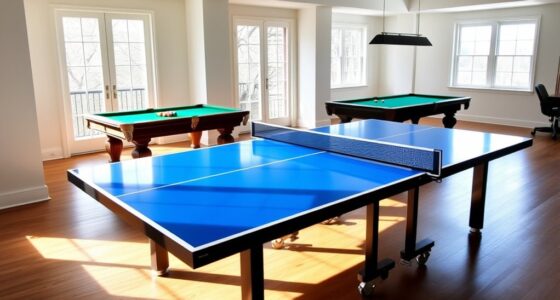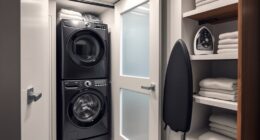To maximize a spare room for your home gym, choose compact, multi-functional equipment like foldable benches, resistance bands, and adjustable dumbbells that save space. Use wall-mounted racks and pegboards to keep everything organized and off the floor. Incorporate foldable cardio machines or jump ropes for effective workouts without crowding the room. Opt for interlocking foam tiles for flooring, and plan a smart layout to make the most of every inch. Keep exploring for tips to transform your small space!
Key Takeaways
- Use foldable, multi-purpose equipment like benches and resistance bands to maximize flexibility and storage.
- Install wall-mounted racks and pegboards to organize and save floor space efficiently.
- Define workout zones with interlocking tiles and keep essential equipment within easy reach.
- Opt for compact cardio machines such as vertical bikes or foldable ellipticals to save space.
- Ensure proper lighting, ventilation, and durable flooring to create a safe, comfortable workout environment.

Creating a small space gym is entirely achievable with strategic planning and the right equipment. The key is choosing versatile, compact items that serve multiple purposes while keeping clutter to a minimum. Workout mats or yoga mats are a great starting point. They provide a padded, slip-resistant surface for bodyweight exercises, stretching, or yoga, and can be easily rolled up and stored when not in use. Foldable workout benches add even more functionality, supporting upper and lower body movements like presses, rows, or step-ups, and they can be tucked away in a closet or corner. Resistance bands with handles and wall anchors are essential for strength training without bulky equipment. They allow you to target various muscle groups, from arms to legs, with minimal space requirements. Adjustable dumbbells are another space-saver, offering a range of weights in one compact package. They let you switch up your resistance levels quickly, making them ideal for progressive strength training. For cardio, look for compact machines such as vertical bikes or stair climbers. These deliver effective workouts while fitting into small nooks or corners, unlike traditional treadmills or ellipticals, which tend to take up more space. Space-saving design strategies are vital in a small gym. Use vertical storage solutions like wall-mounted racks, pegboards, or over-the-door hooks to keep equipment organized. This prevents clutter and maximizes available floor space. When equipment isn’t in use, foldable and multi-purpose items come in handy—think of benches that fold away or squat racks with wall mounts for pull-up bars. Interlocking workout tiles are a smart addition; they create a dedicated workout zone, protect your floors, and are easy to assemble or disassemble if needed. Keep the layout minimal and flexible, focusing on bodyweight exercises and small equipment that require little room. For cardio, opt for low-impact options that conserve space and reduce joint stress. Mini steppers, foldable ellipticals, or vertical exercise bikes fit well into tight spots and still provide a solid cardio session. Jump ropes are a portable, inexpensive choice that only needs a small area to use. Foldable rowing machines can also serve as full-body cardio tools when space permits, offering a compact way to incorporate rowing into your routine. Choosing multipurpose, adjustable equipment maximizes your workout options. Adjustable dumbbells, foldable benches, and resistance bands mimic many gym functions without taking up extra space. Suspension trainers like TRX are lightweight, versatile, and easy to store, providing strength and flexibility training. When considering flooring, durable mats or interlocking foam tiles offer comfort and protection, preventing slips and floor damage. Regular cleaning of mats helps prevent odors in small, less ventilated rooms. In addition, incorporating proper lighting and good ventilation can significantly improve your workout experience in a small space.] By carefully selecting your equipment and employing smart storage solutions, you can create a functional, efficient gym in even the tightest of spaces.
Frequently Asked Questions
What Are the Best Storage Solutions for Gym Equipment?
You want the best storage solutions for gym equipment, so focus on modular racks and shelves that maximize space and keep things accessible. Wall-mounted options like shelves and hooks help conserve floor space, while adjustable shelving and pegboards keep smaller items organized. Durable steel constructions ensure longevity, and creative ideas like under-bed containers or entry benches add extra storage without clutter. Choose versatile, easy-to-maintain solutions for a tidy, functional gym.
How Can I Soundproof My Small Gym Space?
Soundproofing your small gym is like building a fortress against noise. You can start by installing acoustic panels on the walls to absorb echoes and reduce reverberation. Add rubber flooring or impact mats to dampen sound from weights and jumps. Seal gaps around doors with weatherstripping and consider hanging ceiling baffles. Using these strategies, you’ll create a quieter workout space that minimizes noise disturbance effectively.
What Safety Measures Should I Consider in a Small Gym?
You should prioritize safety measures like inspecting and maintaining equipment regularly to prevent injuries. Keep space clear and install impact-absorbing flooring to avoid falls. Secure cables and hide cords to prevent tripping hazards. Clean equipment often to reduce germs and encourage good hygiene. Make sure your space is well-ventilated, and train everyone on proper use and emergency procedures. These steps will help guarantee a safe and effective workout environment.
How Do I Maintain Proper Ventilation in a Small Room?
To maintain proper ventilation, you should open windows to encourage cross-ventilation, use fans to boost airflow, and consider air purifiers to improve air quality. You also need to monitor CO2 levels to guarantee fresh air circulation, keep the room temperature comfortable, and regularly inspect ventilation systems for peak performance. By combining these strategies, you’ll create a healthier, more comfortable environment that supports your activity and well-being.
Are There Any Space-Saving Workout Equipment Options?
You’re looking for space-saving workout equipment options. Foldable or wall-mounted gear like rowing machines, benches, and functional trainers help you save space when not in use. Compact cardio equipment such as mini ellipticals, foldable treadmills, and jump ropes fit easily into small areas. Lightweight resistance bands, dumbbells, and portable accessories like yoga mats and foam rollers also maximize your workout options without cluttering your room.
Conclusion
Transforming a spare room into a gym proves you don’t need a lot of space to stay fit. With clever storage and versatile equipment, you can turn even a tiny corner into your personal workout haven. Did you know that over 60% of people who create a dedicated exercise space are more likely to stick with their routine? So, make that small space work for you—you’ll be surprised how much progress you can see in just a few square feet!









